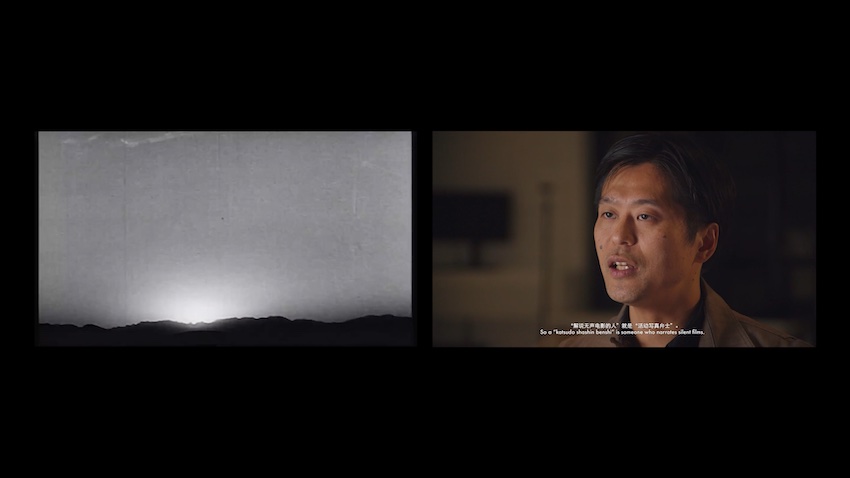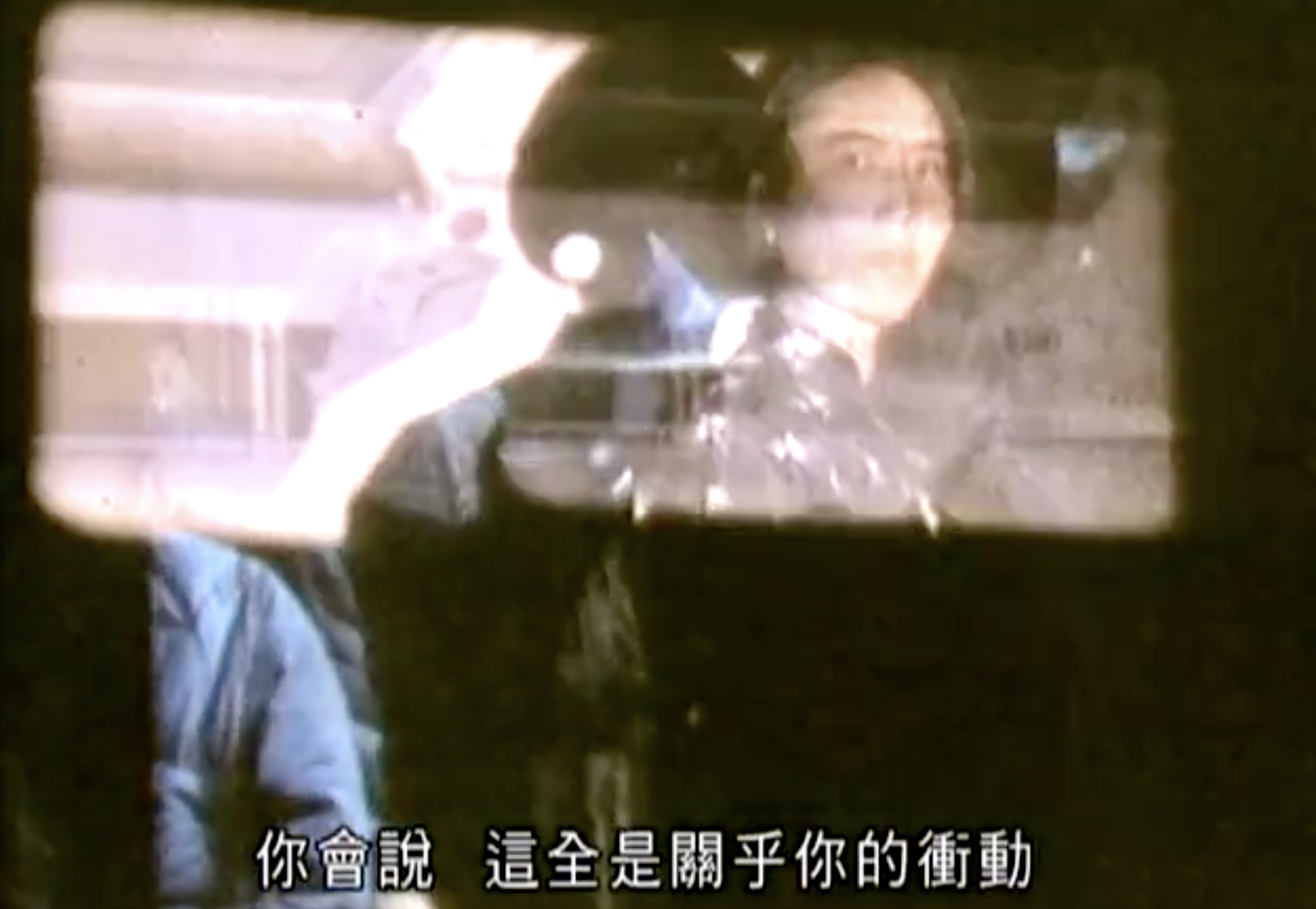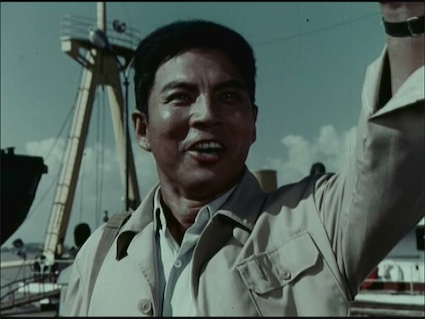Throughout the 20th century, China, Hong Kong and Taiwan have undergone enormous social, political and economic transformations, dramatically reshaping the conditions of everyday life for millions of people. Chinese new media artists have grappled with the uncertainties triggered by these transformations by producing artworks on the fringes of technological possibility.
Spanning the first generation of video art to emerge in the 1980s, through to transportive contemporary works of virtual reality, explore the artworks featured in Afterimage.
About the artworks
CAO Fei 曹斐
b. 1978, China
COSPlayers 角色
2004 single-channel video (colour, sound)8 min.
Fukuoka Asian Art Museum, Japan
Dressed up as game characters, young people are transformed into heroes of a fictional world, able to traverse the city at will. Fantasies of heroes and heroines quickly come up against reality, as these costumed figures enter the real streets and domestic spaces of a Chinese megalopolis.
Making visible a parallel universe of dreams and imagination, COSPlayers speaks to feelings of escapism, alienation and a disaffected youth culture created by China’s rapid urban development and economic transformation. The turn towards virtual spaces has only accelerated in recent years, as China’s Zero COVID policy has made the internet a space of refuge and community for a generation stuck inside.
In that moment when they are turned into genies, chivalrous knights, fairy princesses, or geeks, the pains of reality are assuaged, even if the "real" world they are standing on has not changed to the slightest - Cao Fei

Isaac CHONG Wai 莊偉
b. 1990, Berlin and Hong Kong
One Sound of the Futures–Taipei
2019 single-channel video (colour, sound)9 min. 29 sec.
Courtesy of the Artist and Blindspot Gallery, Hong Kong
By collectively shaping One Sound of the Futures, every participant becomes part of the work. With the form of the performance serving as a metaphor for monuments in public sites, the artist employs the conceptual purport of contemporary art to give the public a chance to talk about historical memories of the future instead of creating an authoritarian, permanent monument. The work transforms hundreds of participants into standing, speaking sculptures and enables people in a time with uncertain political scenes to express their different voices in a stringent form at the same time, interweaving diverse times and voices into an ultimate, intangible moment resounded in a spoken yet indefinable noise that speaks about individual visions of the future.

Green Team 綠色小組
Taiwan
Green TV's Inaugural Film 綠色電視台開播片
1989 single-channel video (colour, sound)11 min. 57 sec.
Courtesy of Green Team
During Taiwan’s Martial Law Period (1949-1987), the governing Kuomintang (KMT) Party tightly controlled all forms of media, including newspapers, radio and television. The three T.V. stations were run by various arms of the state apparatus and politically sensitive topics such as the lifting of martial law or formation of new political parties were banned.
During election campaigns in late 1989, the independent video collective Green Team (1986- 1990) set up an illegal underground satellite transmission channel, broadcasting directly to the people and challenging mainstream coverage of the events. In this inaugural broadcast, Green Team covers a rally held for Taipei County Magistrate candidate You Ching, a voting brigade mobilised by the Hsinchu Veterans’ Society and live “striptease” shows at KMT rallies.
Green Team documented and distributed footage of a wide range of social movements that swept Taiwan in the 1980s, as calls for democracy, self determination and an end to Martial Law saw farmers, environmentalists, veterans, Indigenous communities and human rights activists engage in various forms of civic action and protest. By the time they disbanded in 1990, the so-called “people’s TV station” had created roughly 1,900 VHS tapes with over 3,000 hours of footage.

Linda Chiu-han LAI 黎肖嫻
b. 1957, Hong Kong
Voices Seen, Images Heard 看得見的聲音, 聽得見的形象
2009 single-channel digital video (colour, sound)28 min. 3 sec.
Artist’s edition of the work made available for temporary loan courtesy of the Artist © Linda Chiu-han LAI
Fragments of archival and fictional film, photographs and sound are assembled into a critical history of everyday life in the former British colony of Hong Kong.
Using a research-based practice, Lai considers how Hong Kong has been constructed in image and in language - through cinematic visions, the colonial gaze, and the circulation of typical images of the city (e.g. the junk boat, Victoria Harbour, the skyscrapers of the financial district).
Amidst these fragmented representations, the city itself disappears and reappears from view. Looking for the sights and sounds of Hong Kong, Lai reconstructs a lost history that is imprinted on the archival record while also complicating the neat stories and neat conclusions of inherited narratives. Liberated from the constraints of discourse, history becomes something both intimate and distant.

HAO Jingban 郝敬班
b. 1985, China
Forsaken Landscapes 被嫌弃的风景
2021 HD dual-channel video installation43 min. 45 sec.
Courtesy of the Artist and Blindspot Gallery
Forsaken Landscapes combines montages of Chinese and Japanese documentary and propaganda films from the 1930s and 1940s. These images are interwoven with footage of a live reinterpretation by a “benshi”, a Japanese performer who narrates and interprets silent films.
The work is based on the artist’s research into the Manchukuo Film Association (or Man'ei, 1937-48), a Japanese propaganda-film company based in occupied Manchuria during the 1930s and 1940s when Manchukuo (present day Manchuria) was a puppet state of the Empire of Japan. The facility was later taken over by the People’s Republic of China (PRC) after the Second World War to produce propaganda films.
Both Japanese colonial and Chinese regimes sought to capture the vast landscape, exploiting and embellishing it in cinematic representations for ideological purposes. Through the eyes of various occupiers, Hao Jingban explains:
This landscape takes on a shifting array of symbolism: the land of aspirational pioneers, the brutal battlefields in the war, the rich black earth that yields for the Socialist spirit, and the slowly declining rust belt in the Northeast.
Stripped of context and narrative, these now “forsaken” images are reinterpreted to draw out relationship between image, narrative, history and ideology. Unearthing a forgotten history, Hao poses the question: can these Manchurian landscapes ever be free of politics?

Ellen PAU 鮑藹倫
b. 1961, Hong Kong
For Some Reasons 為了某些原因
2003 single-channel digital video (colour, sound)6 min. 40 sec.
M+, Hong Kong © This edition of work is produced and archived in Videotage Media Art Collection
For Some Reasons is a video essay made in response to the attempt to pass Article 23 of Hong Kong’s Basic Law in 2003. This bill, which would have introduced sweeping changes to Hong Kong’s national security laws, provoked citywide protests as Hong Kong residents responded to this threat to civil liberties. The government shelved the bill in response.
The video opens with the phrase “For some reasons”, a figure of speech used by the administration of then Chief Executive Tung CheeHwa in reference to the proposed law.
Chinese phrases that centre on the formulation “cannot” (“ 不 起 ”) – “cannot fly”, “cannot remember” - move over a shifting and distorted cityscape. Changes to a single character produce a change in meaning.
Fractured across surfaces, the installation of the work evokes the new fragmentations in Hong Kong society created by the introduction of the National Security Law in 2020, which made illegal acts of secession, subversion, sedition and treason. Over 150,000 people have left Hong Kong since this law was imposed.

WANG Jun-Jieh 王俊傑
b.1963, Taiwan/中華⺠國 臺灣
FACE/TV
1989single-channel video (colour, sound)13 min. 7 sec.
© 王俊傑 Wang Jun-Jieh. Courtesy the Artist and Chi-Wen Gallery, Taiwan / 中華⺠國 臺灣
Wang Jun-jieh’s video artworks created between 1984 and 1999 echoed the course of world history in a delicate manner. After the lifting of martial law in the nascent democratized Taiwan, the artist, without any source of reference, created five video artworks, including FACE/TV, addressing criticism against mass media and political hegemony.
Using a satirical approach, FACE/TV questions if the images that we see on T.V. are identical to the objects being captured.

WANG Jun-Jieh 王俊傑
b.1963, Taiwan/中華⺠國 臺灣
HB-1750
1998single-channel video (colour, sound)56 sec.
© 王俊傑 Wang Jun-Jieh
HM-1756
2002single-channel video (colour, sound)36 sec.
© 王俊傑 Wang Jun-Jieh
Courtesy the Artist and Chi-Wen Gallery, Taiwan / 中華⺠國 臺灣
HB-1750 and HM-1756 form part of a series of video and installation works on virtual products created by Wang Jun-jieh in the early 1990s under the theme ‘a gift to hundreds of millions of consumer lovers’ (For Our Consumer Loving).
HB-1750 fabricates a magic pill that takes you back in time to your youth in under a minute, responding to a dream that people have had for centuries: to live for eternity. It shows the complex interaction and disillusionment between desire and reality in contemporary society.
HM-1756 is a fictional diet juice. Losing weight has become the hottest topic of the modern age. The social relationships and desire that are reflected in the appearance of a body not only stimulate economic consumerism, but also blur people’s sense of autonomy over their own bodies.

YAU Ching 游靜
b.1966, Hong Kong
Is There Anything Specific You Want Me to Tell You About? 你有什麼特別的要我告訴你?
1991single-channel video (colour, sound). Original in 16mm film with two audio channels11 min. 7 sec.
Courtesy of the Artist Produced, directed, scripted, shot and edited by Yau Ching.
It started off as a personal letter I imagined a woman like me would write to, say, a lover back home. I initially had an image in mind to talk to but gradually that image fell apart, became obscure, diverse and unrecognisable. Amidst the minute, unconnected pieces I had to ‘make up’ that image myself. Making this film forced me to rethink my relationship with that image and if possible, exorcise it. - Yau Ching
Excerpting movies, travel shows, archival government footage and historical photographs, this film essay interrogates the politics of representation in relation to questions of gender, exile and cultural translation. Pulling fragments from across time and space, Yau asks how one might construct a sense of self as the grand narratives of history fall apart.

Danny YUNG 榮念曾
b.1943, Hong Kong
Video Game 錄影遊戲
1986single-channel video (colour, sound).12 min. 35 sec.
Video: Danny Yung Performer: Pia Ho © Danny Yung
‘The name of the game is dialogue.’
So opens Video Game, a game in which the rules are simple but there is no way to win. Made two years after the signing of the Sino-British Joint Declaration in 1984, a treaty between China and the United Kingdom which set the terms for the transfer of Hong Kong’s sovereignty after July 1 1997, Video Game can be read as a metaphor for Hong Kong’s position in the 1997 handover negotiation.
The work foregrounds the power relations and inequalities between interlocutors, suggesting that the ones capacity to win depends on who controls the game.

ZHANG Peili 张培力
b.1957, China
Happiness 喜悦
2006 dual-channel video (colour, sound)6 min. 32 sec.
White Rabbit Collection, Sydney. Donated through the Australian Government's Cultural Gifts Program by Judith Neilson
Happiness uses appropriated footage from a 1975 propaganda film, drawing from the remnants of public cinematic memory.
On one screen, heroic workers appear to be giving rousing revolutionary speeches, which are greeted by the rapturous applause that once punctuated the orations of Mao Zedong. In fact, they are stating banal phrases (“What?”, “Right, okay”). The enthusiasm of the crowd is revealed to be a superficial performance of ideology, as they gaze towards a once utopian dream emptied of its original promise.

ZHU Jia 朱加
b.1963, China
Related to Environment 与环境有关
1997single-channel digital video projection (colour, sound)19 min. 15 sec.
M+, Hong Kong © Zhu Jia
A goldfish jerks and flops, struggling to breath out of water.
A symbol of prosperity and luck common to Chinese households, the goldfish here is trapped out of context, stuck in a cycle without beginning or end.

Want to know more?
For more information about Afterimage and associated research, contact the exhibition curators